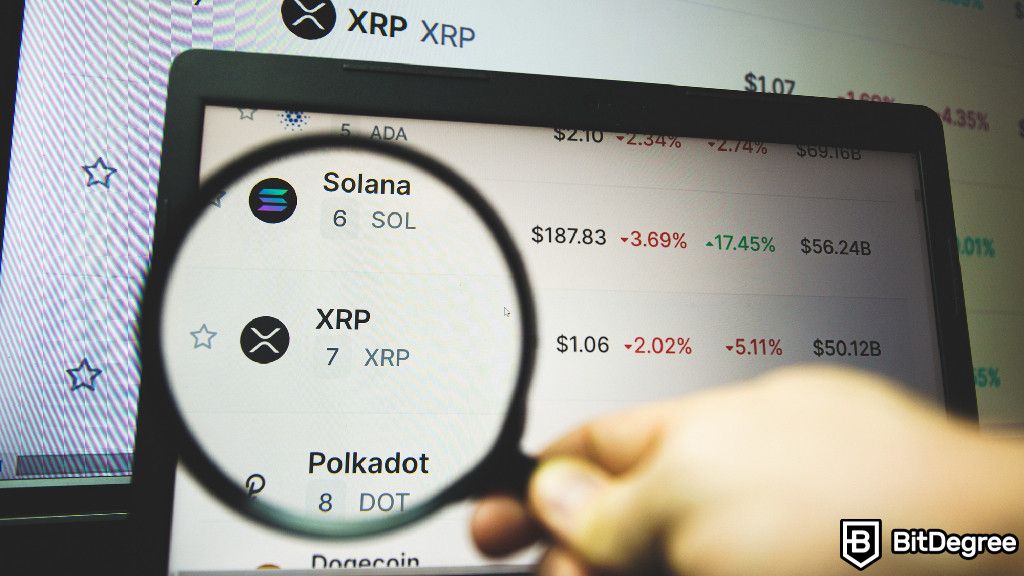Key Takeaways
- Staking cryptocurrencies is a popular way for investors to earn income by holding and validating transactions on blockchain networks;
- Selecting the best staking crypto assets depends on various factors, including APY, the stability of the cryptocurrency, individual goals, and risk tolerance;
- Investors can stake their crypto through various methods, such as exchanges, validators, and staking pools.
Stop overpaying - start transferring money with Ogvio. Join the waitlist & grab early Rewards NOW! 🎁
Finding the best staking crypto is becoming increasingly difficult due to the growing number of various digital assets. This field emerged as a popular way for crypto enthusiasts to earn rewards. In addition, when staking cryptocurrencies, you also contribute to the security and efficiency of the blockchain network.
What's more, you need to know the right place to stake your crypto. Leading exchanges like Binance, Bybit, and Kraken have made staking easier. They offer hundreds of the best crypto for staking and an easy staking process.
So, if you are looking for a way to earn passive income but don't know which cryptocurrencies you want to use, let's explore the best staking crypto coins.

Did you know?
Subscribe - We publish new crypto explainer videos every week!
What is Crypto Arbitrage? (Risks & Tips Explained With Animation)


Table of Contents
- 1. Understanding Crypto Staking
- 1.1. What is Crypto Staking?
- 1.2. Where to Stake Crypto
- 2. Top 6 Best Staking Crypto Coins
- 2.1. Ethereum (ETH)
- 2.2. Solana (SOL)
- 2.3. Cardano (ADA)
- 2.4. Polkadot (DOT)
- 2.5. Tezos (XTZ)
- 2.6. Pocketcoin (PKOIN)
- 3. How to Choose the Best Staking Crypto
- 3.1. Cryptocurrency
- 3.2. Reward Rates
- 3.3. Staking Requirements
- 4. Conclusions
Understanding Crypto Staking
Before diving into the best staking crypto coins, it's important to understand the basics. Therefore, let's begin by first understanding this method of making passive income, so you can be better equipped to make informed decisions.
Latest Deal Active Right Now:What is Crypto Staking?
Crypto staking is a process where you lock up a specific number of your digital assets in a blockchain network to support its operations. So, instead of just holding onto your cryptocurrency, you can lock it, which helps keep everything running smoothly. In return, you earn rewards, kind of like earning interest on a savings account.
Now, let’s discuss crypto staking in more detail. Crypto staking is closely tied to the concept of consensus mechanisms, particularly Proof of Work (PoW) and Proof of Stake (PoS).
PoW consensus mechanism, used by cryptocurrencies like Bitcoin (BTC), involves miners competing to solve complex mathematical puzzles to validate transactions and create new blocks. It’s effective but uses a ton of energy and computing power.
PoS consensus mechanism, on the other hand, is where staking comes into play. PoS is more energy-efficient and relies on validators[1] who are chosen based on the number of coins they hold and are willing to "stake" as collateral.

These validators are responsible for checking transactions and adding them to the blockchain. Because it doesn’t require massive amounts of computing power, PoS is seen as a more eco-friendly option.
So, when you stake your crypto, you’re helping to keep the network secure and running smoothly, and in return, you earn rewards. It’s a win-win, making it an appealing way for many crypto holders to earn a little extra while contributing to the blockchain’s success.
Where to Stake Crypto
Now that you understand what it means, let’s discuss where to stake your assets to potentially earn the best staking crypto rewards. There are several options available, each with its own advantages and considerations.
Staking on Exchanges
Many cryptocurrency exchanges like Binance, Bybit, and Kraken now offer built-in staking features, often with a user-friendly interface and minimal technical knowledge required. These features allow you to participate as a validator in a Proof-of-Stake consensus mechanism by locking your assets directly on the platform.
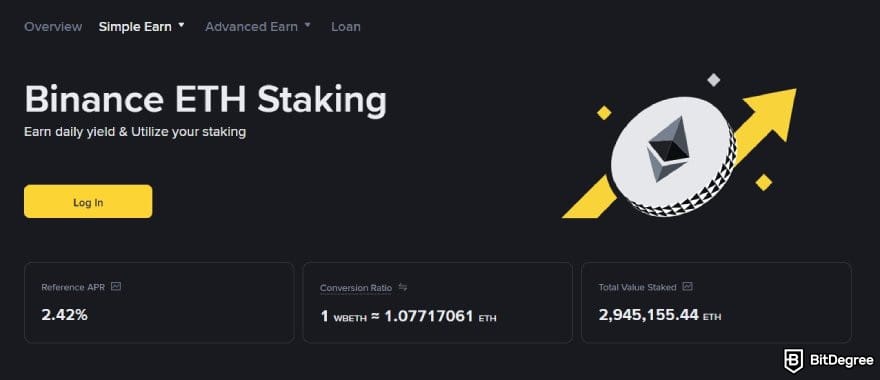
Convenience comes at a cost, however. While exchange staking can be a good entry point, returns may not be the most competitive. Additionally, you might be limited to staking only the specific coins supported by the platform.
📚 Check Out: A Guide to Binance Staking
Staking Through Validators
For more control and potentially higher rewards, you can consider staking directly with validators. This involves choosing a reputable platform on the blockchain network of your chosen cryptocurrency.

This method offers great flexibility and potentially the best staking crypto rewards. On the other hand, it also requires more technical knowledge and involves interacting with validator wallets.
Staking Pools
Staking pools offer a middle ground between convenience and control. These pools aggregate the holdings of multiple users and delegate them to a validator on their behalf.
Therefore, users with smaller holdings can participate and potentially earn rewards while reducing the technical complexities.
In staking pools, the returns might be slightly lower compared to direct validator staking due to fees associated with pool management.
More importantly, choosing the best staking crypto platform depends on your experience level, risk tolerance, and desired level of control. For beginners, it's recommended to start off on an exchange platform, as it offers a good starting point.

More experienced users comfortable with some technical aspects might explore staking through pools to maximize their chances of receiving the best reward.
Top 6 Best Staking Crypto Coins
Now, after covering the fundamentals and exploring different ways of how to stake, it's time to discuss the best staking crypto coins. Choosing the right ones can greatly impact your rewards and overall experience. With many options available, let's see some of the best crypto for staking.
Ethereum (ETH)
Ethereum (ETH) isn’t only a major player in the crypto world but also a frontrunner among the best staking crypto coins. Widely recognized for pioneering smart contracts, Ethereum has established itself as a cornerstone of decentralized applications (dApps) and innovation within the blockchain space.
📚 Read More: Ethereum Staking: Risks, Rewards, and More
That said, this isn’t the end of the road for Ethereum. A significant transformation was achieved with Ethereum 2.0, a major upgrade that transitioned the network from PoW to a PoS consensus mechanism.

This upgrade managed to significantly improve Ethereum’s energy efficiency by over 99%,[2] making it a more sustainable network. However, the most exciting aspect for crypto enthusiasts might be the opportunities to earn staking rewards.
By participating in Ethereum staking, users essentially contribute their ETH holdings to the network's security and smooth operation. In return, they are given a portion of the rewards.
So, what are the best ways to participate? There are several methods to stake ETH, and the rewards you earn will depend on the one you choose. That said, here are some of the options:
Solo Staking as a Validator
Running your own validator node offers the most potential for earning rewards. Ethereum’s Proof of Stake network yields hover around 3% to 4% as of mid-2025. However, this method requires the most technical expertise. You’ll need to run a validator node, which involves keeping a dedicated computer online 24/7 and having a minimum stake of 32 ETH.

Delegating ETH to a Validator
If you don’t have the technical know-how or the required capital to run your own node, you can still participate in staking through delegation. This involves contributing your ETH to a validator who is already running a node. In exchange for letting them use your staked ETH, you’ll receive a portion of their rewards.
Always choose a reputable validator or staking service, as delegating your ETH involves trusting a third party with custody and reward distribution.
You can still expect a return of around 3% to 4% APY with this method as of 2025. Therefore, delegation is a good middle ground for those who want to stake but don’t have the technical skills or resources for a validator node.
Pooled Staking
Another option is to participate in a staking pool. Similar to delegation, this method allows you to combine your ETH with other participants and share the rewards from a validator that the pool runs.

This is a convenient option for smaller ETH holders who don't have enough tokens to meet the minimum requirements for individual delegation. Using Rocketpool as the reference, you can expect around 2.5% to 3.3% APR with this method.
Centralized Exchange Staking
The simplest way to stake Ethereum is through a centralized exchange (CEX), a platform that facilitates cryptocurrency trading.[3] Exchanges like Binance, Bybit, and Kraken allow you to stake your ETH directly on their platform. This is the easiest option as it requires no technical knowledge - the exchange handles everything for you.
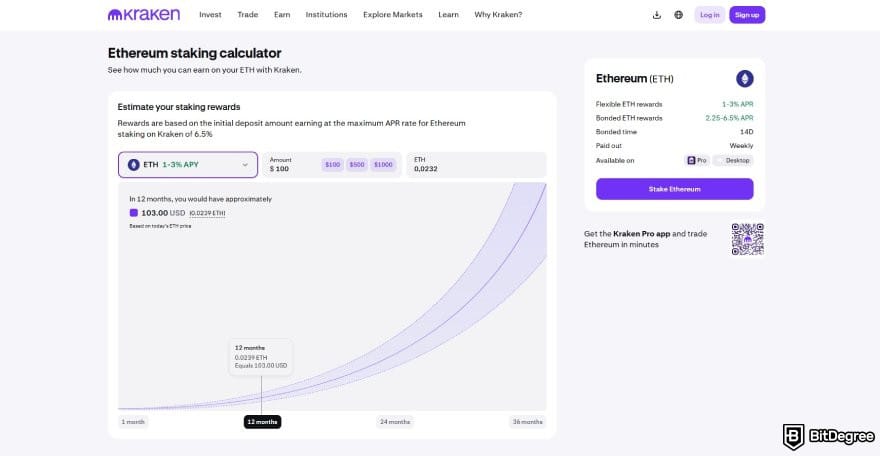
Overall, with the transition to PoS and the potential for best staking crypto rewards, Ethereum presents a compelling option for those seeking passive income.
Since exchanges manage the staking process, they take a cut of the rewards. This means you might earn less than with other methods this way, typically from 1% to 6% APR, depending on the staking flexibility.
Also, remember that staking rewards aren’t guaranteed and can fluctuate based on various factors. So, it’s important to consider your risk tolerance and technical skills when choosing a staking method.
Solana (SOL)
Solana (SOL) has carved a niche for itself as a serious contender in the best crypto to stake arena. While Ethereum has a strong reputation, Solana boasts unique features that set it apart. What are they?
This high-performance blockchain is renowned for its fast transaction speeds and exceptional scalability. Therefore, it becomes a network capable of efficiently handling massive transactions.

Solana achieves this through a unique consensus mechanism that combines Proof-of-History (PoH) with PoS. PoH essentially allows the network to cryptographically timestamp events,[4] ordering transactions before they even enter a block. This innovative approach streamlines the validation process and contributes to Solana’s fast performance.
That said, when it comes to the best crypto staking coins, Solana offers a compelling proposition for those seeking to earn passive income on their SOL holdings. Similar to Ethereum, the rewards on Solana are distributed based on the number of SOL staked and the network's activity.
📚 Read More: How to Stake Solana
The rewards you earn will differ depending on your chosen staking method. So, let’s discuss the options for staking Solana.
Running a Validator Node
The most lucrative way to stake Solana is by running your validator node. This method allows you to earn rewards that could even surpass the average yield, which sits around 7% APY.

However, it's a demanding process, just like running an Ethereum validator node. You’ll need significant technical expertise to keep your node constantly online and operational. No minimum amount of Solana is required to participate, but running a reliable node involves using hardware and doing relatively costly maintenance.
Delegating SOL to a Validator
For a more accessible option, you can delegate your SOL to a validator. This is the most common way to stake Solana. Delegation involves choosing a validator on the network and assigning your SOL tokens to them.
In return for using your staked SOL to secure the network, you’ll receive a portion of the validator’s rewards. After accounting for the validator’s commission, you can expect to earn around 5% to 6% APY.
Using Staking Protocols
A recent development in Solana is the use of staking protocols. These platforms act like middlemen, managing the process for you. In addition, staking protocols allow you to automatically delegate your SOL to validators with good track records and competitive commission rates.
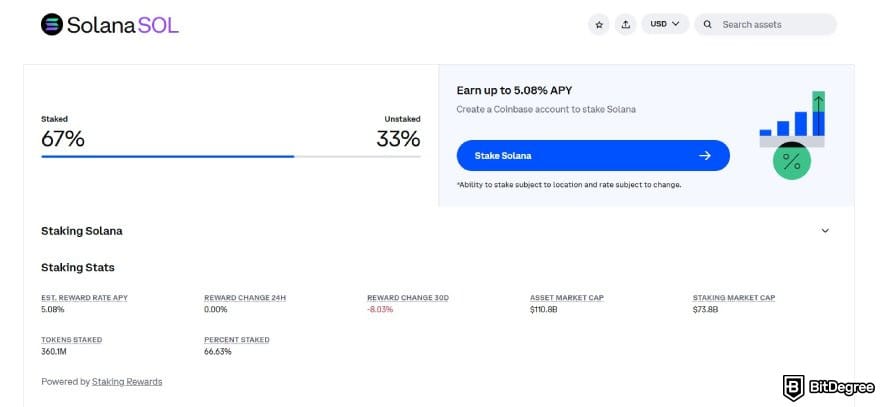
All in all, Solana presents a promising option for users seeking a high-performance blockchain with attractive staking rewards and lower fees. That said, Solana's rewards can fluctuate based on various factors, such as validator performance and the total amount of staked SOL on the network.
While the potential returns with staking protocols are on par with individual delegation (around 5% to 6% APY), it’s important to note that some protocols might charge fees. This will slightly reduce your overall rewards.

Did you know?
Subscribe - We publish new crypto explainer videos every week!
How Do KYC & AML Work in Crypto? (Explained)


Cardano (ADA)
Cardano (ADA) is another strong contender among the best staking crypto coins. This innovative blockchain network stands out for its research-based and peer-reviewed development methodology. Cardano’s technology is designed to be secure, scalable, and environmentally friendly.
At the heart of Cardano lies the Ouroboros protocol, a unique PoS system specifically designed for efficiency and security. Ourorobos utilizes a secure selection process to choose validators, ensuring the network remains resistant to malicious attacks.

For those interested in finding the best crypto staking coin, Cardano offers an opportunity to participate in its Ouroboros protocol and earn rewards in ADA tokens. While APY estimates can vary, they typically fall within a range that makes ADA an attractive option for passive income generation.
📚 Read More: A Guide to Cardano Staking
Now, you might wonder where to stake your ADA holdings and earn the best crypto staking rewards. To answer that question, let's explore several Cardano options.
Using a Full Node Wallet
A full node is a computer that stores and validates the entire history of a blockchain. So, when you combine a crypto wallet with a full node, you get a wallet with direct access to the complete blockchain, giving you complete control and support for the blockchain network.

Therefore, it makes it an appealing choice for its security benefits and direct network participation.
Using a full node wallet doesn’t directly influence your rewards. Cardano’s system distributes them proportionally based on the amount of your staked ADA and the overall network’s health.
Regardless of whether you use a full node wallet, you can expect average returns of around 4% to 5% APY. Additionally, the main advantage of a full node wallet lies in its ability to verify transactions and contribute to the network’s decentralization independently.
Delegating ADA
For a more user-friendly experience, it's recommended to choose a staking pool to delegate your ADA. These stake pools are essentially groups that validate transitions on the network.

The return on your delegated ADA depends on the chosen pool’s performance and the commission they charge. Generally, you can expect returns comparable to using a full node wallet, around 4% to 5% APY.
Staking on a Centralized Platform
Centralized staking platforms, offered by cryptocurrency exchanges, provide the easiest way to stake Cardano. There’s minimal setup involved, and no technical knowledge is required.
However, this convenience comes at a price. Centralized exchanges typically take a cut of the staking rewards, meaning you’ll generally earn less than delegating directly to a stake pool. If you choose this route, expect returns slightly lower than the network average. For example, the estimated APY for staking ADA on HTX is around 3%.
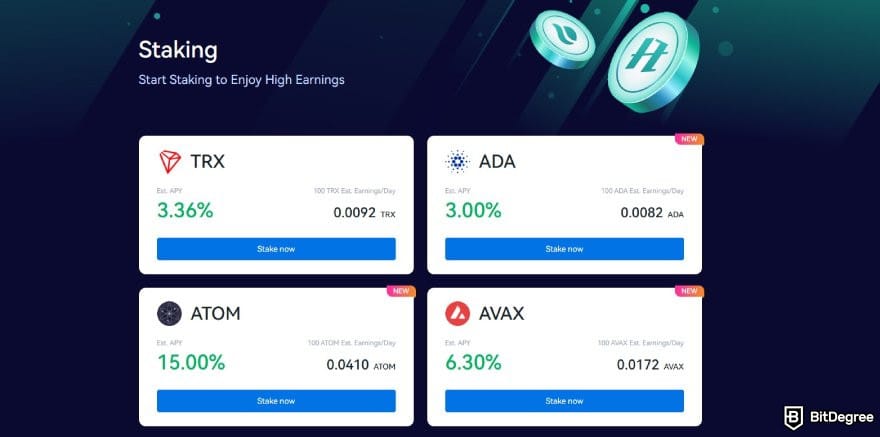
With its innovative blockchain technology and focus on security and decentralization, Cardano offers a compelling option if you want to participate in one of the best crypto staking coin networks. However, remember that Cardano rewards aren’t fixed and can fluctuate based on the total number of delegated ADA and the network’s activity.
Polkadot (DOT)
Polkadot (DOT) stands out as one of the best crypto for staking coins with its innovative approach to blockchain interoperability. What's worth highlighting is that Polkadot allows different blockchains to connect and communicate with each other, which is different from traditional ways. This creates opportunities for a future where various blockchains can work together and exchange data.
To do that, Polkadot utilizes a unique consensus mechanism: Nominated Proof-of-Stake (NPoS). In NPoS, DOT holders nominate validators who are responsible for securing the network and verifying transactions. This nomination process allows for a more distributed and secure validation system compared to the PoS mechanism.

If you’re looking for the best crypto to stake, Polkadot offers an opportunity to earn profit in DOT tokens. However, unlike some other options, staking rewards on Polkadot can vary depending on several factors, including the chosen parachain (a blockchain connected to Polkadot) and the overall network activity.
📚 Read More: A Guide to Polkadot Staking
You can stake Polkadot through several native staking methods. Here’s a breakdown of the different options and what you can expect in terms of returns:
Opening a Nomination Pool
By opening a nomination pool, you allow multiple users to combine their DOT and participate in staking together. This does not make you a validator. Instead, your pool delegates stake to existing validators. The estimated returns for nominators and pool members are usually around 10%–14% APY, depending on validator performance and network conditions.
Becoming a validator, on the other hand, requires significant technical expertise, a robust setup, and a large self-bond.
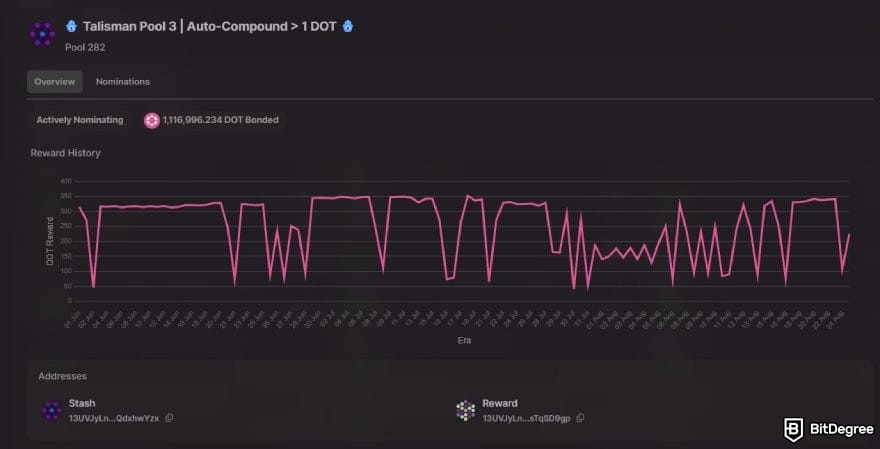
As a validator, you’ll be responsible for running a node and validating transactions on the network. If you behave poorly or commit misconduct, you risk being slashed or losing some DOT tokens. So, maintaining a secure node also requires constant effort and attention.
Nominating Validators Directly
For a less demanding approach, you can nominate validators on the Polkadot network. This involves bonding your DOT and selecting trusted validators to support. In return, you’ll earn staking rewards proportional to your stake, minus a small commission taken by the validator.

Returns typically range from 10% to 14% APY, depending on validator performance. Be sure to research validators carefully, as their reputation and uptime can directly affect your rewards.
Joining a Nomination Pool
As mentioned earlier, nomination pools are an excellent option for staking DOT, but you don’t have to create one to participate. The simpler approach is to join an existing pool, which lets you stake with as little as 1 DOT. By doing so, your funds are combined with other members and used to nominate validators collectively.
Rewards are distributed to pool participants based on their stake. You can expect returns comparable to direct nomination, potentially around 10% to 14% APY.

Polkadot can be a great choice for users interested in a future-oriented blockchain with a unique staking system. Remember that rewards from staking aren’t guaranteed. Factors like the total number of delegated DOT and validators actively participating in the network, and the commission rates of your chosen validators, play a role in determining your final returns.
Tezos (XTZ)
Tezos (XTZ) is one of the best staking crypto coins due to its unique emphasis on on-chain governance. Unlike most blockchains with fixed protocols, Tezos empowers XTZ holders to vote on proposals that can modify the network’s rules. This allows Tezos to adapt and evolve, fostering a dynamic and community-driven ecosystem.
Tezos' on-chain governance is a decentralized framework that allows you to propose, vote on, and automatically implement changes to the network.
Central to Tezos staking is its Liquid Proof-of-Stake (LPoS) consensus mechanism. In LPoS, XTZ holders delegate their tokens to validators, known as “bakers”. These bakers are responsible for securing the network and validating transactions.
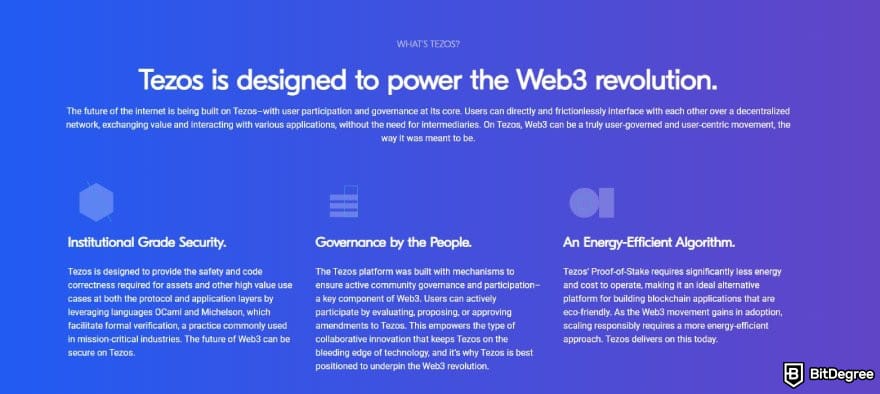
Moreover, the true advantage lies in on-chain governance. By delegating your XTZ to a baker, you indirectly influence the future direction of the Tezos network. This empowers users and fosters a sense of community ownership within the Tezos ecosystem.
So, how do you stake your XTZ and earn one of the best crypto staking rewards from Tezos? There are several ways to do that:
Delegating XTZ
The most common and user-friendly way to stake Tezos is through delegation. In this method, you assign your XTZ to a baker on the network. Many non-custodial wallets, such as Ledger or Temple, make this process easy by providing built-in delegation options.

In return for delegating your XTZ and contributing to the network’s security, you receive a portion of the baker’s rewards. The average returns for delegating XTZ might range from 5% to 7% APY, but this can vary depending on the commission rate charged by the baker and the overall network conditions.
Running a Validator Node
If you’re looking for potentially higher rewards, consider running your own node, known as “baking”. This method allows you to earn a larger share of the rewards compared to delegation, with estimates reaching around 6% to 8% APY.
However, similar to running a validator node in other blockchains, it’s a demanding process. You’ll need significant technical knowledge to maintain your own node, which must be constantly online. There’s also a minimum amount of XTZ required to participate as a baker.
Staking on a Centralized Exchange
For those who prefer a simple and hassle-free approach, staking XTZ on a centralized exchange can be an option. This method requires no technical knowledge and minimal setup.
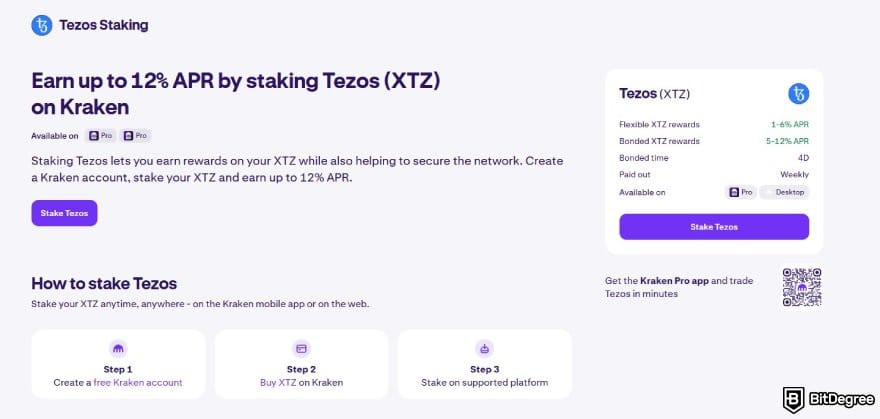
However, centralized exchanges typically take a cut of the staking rewards. So, you might earn less compared to delegating your XTZ to a baker. For example, you can expect around 1-6% APR for a flexible term when staking Tezos on Kraken.
For users seeking a forward-thinking blockchain focusing on on-chain governance, Tezos might be the one you’re looking for. That said, Tezos staking can fluctuate like any other option. So, always research current yields and baker commission structures before delegating your XTZ.
Pocketcoin (PKOIN)
Pocketcoin (PKOIN) is the native asset of Bastyon (formerly PocketNet), a decentralized social media and mini-app platform focused on privacy, free speech, and censorship resistance (visited by more than 1.6 million users monthly).
Unlike traditional social networks, Bastyon doesn’t rely on corporate control or centralized servers. Instead, it runs on a blockchain, where users earn PKOIN for engaging with content, advertising, and peer-to-peer transactions. But beyond that, PKOIN staking offers another way to earn while supporting the network’s security.
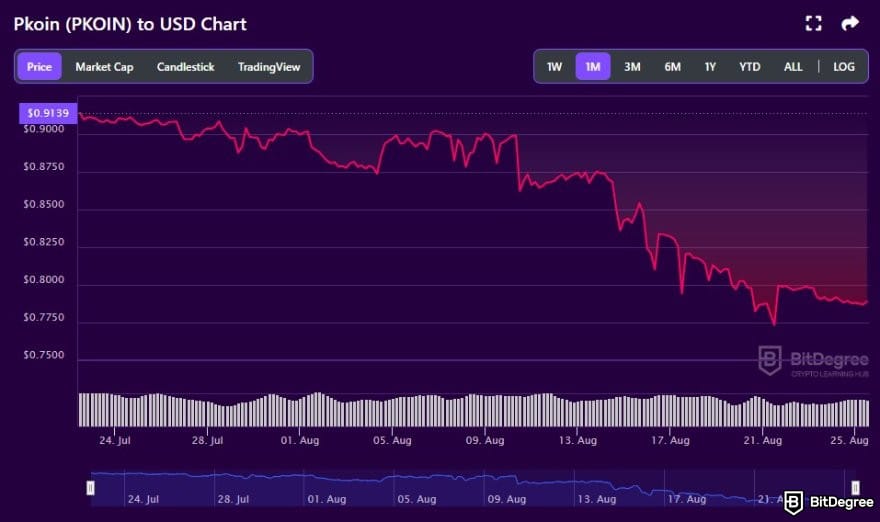
If you’re looking for high-yield staking, PKOIN might just be one of the hidden gems in crypto. Based on many claims online, the staking rewards sit at 30%+ APY, making it one of the more lucrative options in the space.
Keep in mind that many of these claims come from self-published or promotional materials. The estimated APY can vary significantly depending on network conditions and how staking is structured.
Do note that your rewards scale with the amount of PKOIN staked – more tokens mean more earnings.
Running a Bastyon Node
PKOIN is built on the Pocketnet blockchain, which powers the decentralized social platform Bastyon. The network operates on a Proof-of-Stake (PoS) mechanism, and users can stake PKOIN by running a node. Here’s what you need to get started:
- At least 50 PKOIN in your node wallet address;
- A computer with 150GB of SSD storage and a stable internet connection (no special hardware needed);
- A Bastyon node, which you just need to download and set up on your computer.
Your staked PKOIN generates rewards as long as your node stays online.

Beyond staking, PKOIN has real-world utility, which sets it apart from most staking coins. It’s already used for advertising, marketplace payments (on Barteron), and content monetization.
And with the wrapped PKOIN version (WPKOIN) on the Base network, listed on Uniswap, its accessibility and liquidity might level up even more.
If you want to earn high APY, PKOIN staking might be a solid bet for you. It’s one of the few crypto assets that isn’t just speculative. It’s already powering a fast-growing platform. With a 30%+ possible staking yield and a deflationary supply, the numbers might be in your favor.
How to Choose the Best Staking Crypto
After exploring the top five best staking crypto coins, let’s discuss the factors you should consider when choosing a cryptocurrency to stake. These factors can help you make a more informed choice that aligns with your investment goals and risk tolerance.
Cryptocurrency
Choosing the right cryptocurrency to stake is crucial for several reasons. First, not all assets offer staking opportunities. Therefore, identifying the best crypto to stake ensures that you're investing in a coin that supports this feature. Additionally, exploring more options can help you find more attractive rewards.
Staking mechanisms can vary between cryptocurrencies. Some may offer higher returns but come with greater risks, while others might provide more stability with lower yields.
Evaluating the underlying technology and the project’s long-term potential can also influence your decision. Staking a cryptocurrency with a solid and active development team can enhance the security and reliability of your investment.

So, carefully selecting the best crypto to stake can significantly impact your overall experience and potential earnings.
Reward Rates
Another crucial step when choosing the best crypto for staking is considering the reward rates. It's crucial to balance them with other factors like the project's stability and risk levels.
Some of the best staking crypto coins, such as Ethereum, Solana, and Polkadot, often offer competitive reward rates that can attract investors.
These rates can fluctuate based on network conditions, staking duration, and the total number of staked crypto.
That said, it’s important to research and compare the rewards of different cryptocurrencies to find the one that aligns with your financial goals. Additionally, understanding the mechanisms behind these rates can help you predict potential changes and make informed decisions.

- Secure and reliable
- Accepts fiat currencies
- Lots of trading options
- Reputable exchange
- Accepts fiat currencies
- Offers various trading options

- Huge trading variety
- Regulation-compliant around the globe
- Fair trading fees
- Beginner-friendly
- A wide array of features
- Vast number of different crypto coins & tokens

- Beginner-friendly
- Secure
- Decent trading and withdrawal fees
- Crypto.com Visa Card
- Automated tools & bots
- Ecosystem synergy with CRO
Staking Requirements
Considering the requirements is vital when selecting the best crypto for staking. Different cryptocurrencies have varying prerequisites, such as minimum coin holdings, lock-up periods, and technical know-how. These requirements can impact your ability to participate and the overall convenience of the process.

For instance, some of the best staking crypto options I've mentioned require a significant initial investment, which might not be suitable for all investors. Others might have complex procedures that require a higher level of technical expertise. Evaluating these factors ensures you choose a cryptocurrency that matches your resources and capabilities.
Understanding staking requirements helps you anticipate any potential limitations or challenges. This knowledge allows you to prepare adequately and avoid unforeseen complications.
By carefully assessing the requirements, you can select the best staking crypto that aligns with your financial situation and investment strategy. This ensures a smoother and more rewarding experience.
Conclusions
Choosing the best staking crypto can significantly enhance your investment strategy by providing passive income. By staking cryptocurrencies like Ethereum, Solana, Cardano, Polkadot, and Tezos, you earn rewards and contribute to the blockchain networks’ security and efficiency.
Additionally, staking through exchanges, validators, or staking pools offers flexibility to fit different levels of technical expertise and investment sizes.
As you navigate the world of crypto staking, it’s crucial to stay informed and consider your risk tolerance, investment goals, and the specific features of each crypto staking option. By doing so, you can maximize your rewards and ensure a more secure and profitable investment experience.
The content published on this website is not aimed to give any kind of financial, investment, trading, or any other form of advice. BitDegree.org does not endorse or suggest you to buy, sell or hold any kind of cryptocurrency. Before making financial investment decisions, do consult your financial advisor.
Scientific References
1. C. T. Nguyen, D. T. Hoang, D. N. Nguyen, et al: ‘Proof-of-Stake Consensus Mechanisms for Future Blockchain Networks: Fundamentals, Applications and Opportunities’;
2. Kapengut E., Mizrach B.: 'An Event Study of the Ethereum Transition to Proof-of-Stake';
3. S. Hägele: ‘Centralized exchanges vs. decentralized exchanges in cryptocurrency markets: A systematic literature review’;
4. M. Ivanov, E. Johnson: ‘A Comprehensive Review of Decentralization Technologies in Bitcoin, Ethereum, and Solana’.
